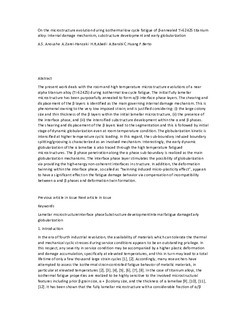| dc.contributor.author | AS, Anoushe | |
| dc.contributor.author | A, Zarei-Hanzaki | |
| dc.contributor.author | HR, Abedi | |
| dc.contributor.author | A, Barabi | |
| dc.contributor.author | C, Huang | |
| dc.contributor.author | Berto, Filippo | |
| dc.date.accessioned | 2019-02-26T08:57:28Z | |
| dc.date.available | 2019-02-26T08:57:28Z | |
| dc.date.created | 2018-11-26T10:24:51Z | |
| dc.date.issued | 2018 | |
| dc.identifier.citation | International Journal of Fatigue. 2018, 116 592-601. | nb_NO |
| dc.identifier.issn | 0142-1123 | |
| dc.identifier.uri | http://hdl.handle.net/11250/2587353 | |
| dc.description.abstract | The present work deals with the room and high temperature microstructure evolutions of a near alpha titanium alloy (Ti-6242S) during isothermal low cycle fatigue. The initial fully lamellar microstructure has been purposefully annealed to form α/β interface phase layers. The shearing and displacement of the β layers is identified as the main governing internal damage mechanism. This is phenomenal owning to the very low imposed strain; and is justified considering: (i) the large colony size and thin thickness of the β layers within the initial lamellar microstructure, (ii) the presence of the interface phase, and (iii) the intensified substructure development within the α and β phases. The shearing and displacement of the β layers lead to the segmentation and this is followed by initial stage of dynamic globularization even at room temperature condition. The globularization kinetic is intensified at higher temperature cyclic loading. In this regard, the sub-boundary induced boundary splitting/grooving is characterized as an involved mechanism. Interestingly, the early dynamic globularization of the α lamellae is also traced through the high temperature fatigued microstructures. The β phase penetration along the α phase sub-boundary is realized as the main globularization mechanisms. The interface phase layer stimulates the possibility of globularization via providing the high-energy non-coherent interfaces in structure. In addition, the deformation twinning within the interface phase, so called as “twinning induced micro-plasticity effect”, appears to have a significant effect on the fatigue damage behavior via compensation of incompatibility between α and β phases and deformation twin formation. | nb_NO |
| dc.language.iso | eng | nb_NO |
| dc.publisher | Elsevier | nb_NO |
| dc.title | On the microstructure evolution during isothermal low cycle fatigue of β-annealed Ti-6242S titanium alloy: Internal damage mechanism, substructure development and early globularization | nb_NO |
| dc.type | Journal article | nb_NO |
| dc.description.version | submittedVersion | nb_NO |
| dc.source.pagenumber | 592-601 | nb_NO |
| dc.source.volume | 116 | nb_NO |
| dc.source.journal | International Journal of Fatigue | nb_NO |
| dc.identifier.doi | 10.1016/j.ijfatigue.2018.07.014 | |
| dc.identifier.cristin | 1634884 | |
| dc.description.localcode | This is a submitted manuscript of an article published by Elsevier Ltd in International Journal of Fatigue, 10 July 2018. | nb_NO |
| cristin.unitcode | 194,64,92,0 | |
| cristin.unitname | Institutt for maskinteknikk og produksjon | |
| cristin.ispublished | true | |
| cristin.fulltext | postprint | |
| cristin.fulltext | preprint | |
| cristin.qualitycode | 2 | |
